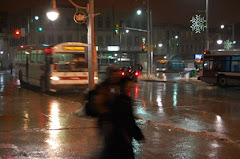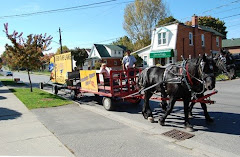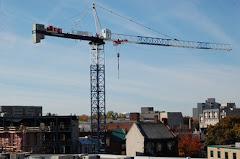It was the best of times, it was the worst of times... That line from A Tale of Two Cities seems apt to describe this year of Guelph Transit news. There seemed to be a renewed focus and urgency on improving Transit services, but the results seemed to leave a lot to be desired according to the people on the ground, or in the bus.
The Good
While not being the victory transit users were looking for in the 2017 budget process, there was a minor victory in that regular holiday service was restored for two stat holidays including the recently passed Boxing Day. Not great, but there were no new cuts or cash fare increases, which were considered victories in the eyes of people taking the bus in Guelph.
In actual good news, there was more money to go around. Recently, the Government of Canada, and the Government of Ontario gave additional funds through the Public Transit Infrastructure Fund (PTIF) for the purchase of three new transit operations vehicles and four hoists. "These purchases will help serve on-route supervision of transit operations and provide more reliable equipment when repairing vehicles," said the City press release.
A splashier announcement of new transit funding took place in March at Transit headquarters, where nearly $9.7 million in new funds were handed out by the Feds and the Province in a province-wide series of similar announcements. New funding initiatives included $7.37 million for replacement buses, $1.3 million for replacing fare boxes with ones that will finally support the student U-Pass and transfers, $363,221 will go to upgrade 132 bus stops to make them accessible and add shelters, $147,500 will go to the development of the Transportation Master Plan, and $500,000 will be invested in upgrading the traffic signal control system to better coordinate traffic signals along busy streets.
The biggest news though in terms of transit improvements was the massive route and schedule realignment, the biggest one undertaken by the system since 2012. According to Transit general manager Mike Spicer, the intention of the widespread alterations was to address missed passenger loads, primarily along the Gordon Street Corridor, and to build a "base system" that would allow for easy expansion as demand increased while at the same time staying within Transit allocated budget.
"The Gordon Street corridor is one area that we're really struggling with, there's probably 20 loads [per day] on average that we're leaving on the sidewalk, which is not good," he said to Politico back in March. "This is the starting point to react quickly to what people are saying to us, which is that the level of service just isn't meeting our needs."
Transit staff spent the next several months workshopping and discussing the changes with the general public, a full-blown charm offensive to make sure a repeat of the public blowback in 2012 did not occur. For the most part, it seemed that the engagement worked, and the months of campaigning was capped off with a star-studded inaugural ride on the new #99 Mainline.
It was, unfortunately, down hill from there.
The Bad
Global News posted an interview with Spicer about the changes on October 3 and attached a poll asking readers how they would grade the realignment. As of this past Friday, almost a third of respondents gave the changes an 'F'.
While that's unscientific, there were undoubtedly issues among riders as they tried to react to transit changes. Spicer talked about the issues with Guelph Today at the end of September, and noted that there were complaints being received about buses being late, however “We can put more buses on there, but the traffic volume won’t alleviate. We’ll just have more buses getting caught in traffic.”
Traffic density, an uptick in accidents, and construction were the reasons that Spicer said were causing upsets along the route. Whatever the reason, people felt left in the dark as they arrived at their bus stop and forced to wait an indeterminate amount of time for their bus to come. With the NextBus system unavailable at many stops through much of September due to the renumbering of stops, and the Google Maps app only occasionally offering an accurate estimated time of arrival, people often felt stuck: do they give up waiting or take a cab, or do they wait because the bus will arrive the next minute? And what about people for whom taking a cab is not an option?
Transit did try to react to that though by being more responsive on social media and posting delays and cancellations. Supervisors were given access to the @GuelphTransit Twitter feed in order to offer users up-to-date information on hiccups in the system, but Spicer believed that time would be the ultimate remedy to the issues. "Once we can tweak some of the timing points, we will alleviate some of the frustration," Spicer told Today.
As Transit was looking for a good news story by the beginning of October, they got one. The City of Guelph announced on October 6 that ridership for September was up 44 per cent over September 2016; 759,053 trips were taken in 2017 as opposed to the 524,694 just 12 months before. Ridership on routes #10, #11, #12, and #20 were the most affected by the increase, while ridership on university buses doubled on three out of four routes. The #99 Mainline saw the most action with 25 per cent of rides taking place at some point along "the spine."
“The numbers clearly show that last month’s route realignment is off to an impressive start and that we’re meeting our goal to put buses where and when people need them the most,” said Spicer in the release.
Still tweaks are being made. Transit announced a series of changes to select routes at the beginning of December.
About half the changes affect university routes, but the most controversial ones will happen on routes #3, #11 and #14, where service will move, in-part or on-while, to a 40-minute schedule; the move will affect the #11 and #14 after 9 pm, but the #3 Westmont will be on an all-day 40-minute schedule. Users of that route are concerned about longer waits for buses and transfers, which is especially problematic since St. Joseph's Health Centre is serviced by the #3. The #41 Downtown-University Express will also be scaled way back to being a morning and afternoon peak-only service.
The "tweaks" go into effect on January 7.
The Ugly
While all this was going, Transit was also renegotiating a contract with its employees, who are represented by the Amalgamated Transit Union Local 1189. The last contract, which came out after the 2014 lockout of Transit employees by the City of Guelph, expired on June 30, and negotiations had continued into the fall. This is, as they say, where the plot thickens.
In a Guelph Today article on October 19, Deputy Chief Administrative Officer for Public Services Colleen Clack suggested that some of the problems with Transit dropping routes was because of an increase in sick calls and cancellation of overtimes shifts. "At this point we are just treating it as an unfortunate moment in time and we are working as best as we can. It obviously causes challenges," said Clack.
This prompted the rumour mill in the community to churn that this was a negotiating tactic by the union, to cause disruptions in service through "sick calls." Andrew Cleary, the President of the union, vehemently disagreed telling the Guelph Tribune that, “As a driver, I’m susceptible to a lot of germs,” he said. “If there’s a spike of illness in the community, then there’s obviously going to be a spike in illness with the operators.”
Cleary added that there was a regular uptick in illnesses among drivers at Back to School time. He also said that Transit drivers were working as much overtime as they could to make up the difference.
The next week, Mayor Cam Guthrie took things up a notch following the Mayor's Dialogue on Poverty. “I believe a lot of the issues that are occurring right now with transit are around the union contract that is being negotiated right now,” the mayor said.
Cleary took exception. "For the Mayor to suggest during negotiations that the membership is complicit in any type of job action is untrue and unfounded," he told Guelph Today. "If this is truly what management at city hall believes, it is the union's position they should file a complaint with the Ministry of Labour."
By the end of November, a new deal had been reached and both sides had ratified it rather easily. Still, it was obvious that Cleary was still troubled by Guthrie's October comments saying in response to a Guelph Politico query on the agreement, "ATU 1189 showed commitment in bargaining this deal to ensure no service disruption," he said.
Despite everything being settled with labour, Guthrie again stoked controversy when he pondered on Twitter about privatizing transit service. “Everything should be on the table and that same question should be on the table for all services, not just transit," he told Guelph Today. “I don’t think there is a fear of privatization at all. I think that unions can really speak so loudly in regards to this with a lot of fear, that it shuts down what could be a very good discussion on the topic.”
That discussion will begin in another year when the service review of Transit is complete. In the meantime, consider this: of the two main regional carriers, one is publicly-owned and the other is private. In 2017, one of them increased service, and the other one cut it. Guess which is which.
Know Your Rights?
Finally, someone online ask the question about whether or not public transit was a right. Well, it may not be a part of the Charter of Rights and Freedoms, but the necessity of expanding and improving public transit is mentioned in the recently passed Official Plan Amendment 48. Starting from Page 72 of the amendment:
1) The City shall continue to increase connectivity and integration between public transit and other modes of travel through measures such as installing bicycle racks on buses, including bicycle parking at transit terminals, designing for pedestrian and cyclist access to terminals and providing for ”park and ride” opportunities.
2) To ensure that public transit is an attractive, energy efficient and convenient means of travel the City will:
i) plan for a compact urban form by promoting mixed and transit- supportive land uses, urban intensification, a strong Downtown and urban structure of nodes and corridors as identified on Schedule 1;
ii) consider public transit as a high priority for transportation infrastructure planning, second only to active transportation;
iii) ensure the creation of a road network that permits reasonable walking distances to and from transit stops for a majority of residences, jobs and other activities in the area;
iv) ensure that the phasing of new development allows for the provision of transit service in the early phases of new development so that using transit is a viable option for the first occupants;
v) require development proponents to plan for the provision of transit in an integrated and comprehensive manner including the location of transit routes and facilities, where appropriate; and
vi) consider the impacts on transit when planning the locations for higher density housing, commercial and employment centres.
3) In addition to transit-supportive land use development, a high level of service, reliability and amenities are needed to attract riders. The City will promote greater use of transit by:
i) maintaining efficient transit service through improvements to travel time, reliability, overall routes and regularity of service, especially for those routes that link areas of population and employment concentrations;
ii) providing transit priority measures to lessen delays on transit vehicles caused by traffic congestion and traffic control signals, where appropriate;iii) ensuring that bus stops are provided at regular intervals, generally within 400 metres of every residence and business, to promote accessibility to all areas;
iv) providing adequate facilities to improve rider amenities such as bus stop shelters and routes and schedule information; and
v) facilitating access to public transit for persons with disabilities by providing special equipment and services where warranted, designing stops, shelters and terminals for accessibility and taking other actions that facilitate improved access to transit services.
4) In the review of development applications that involve major traffic generators and of facilities potentially used by transit riders, the City may require the provision of on-site or off-site facilities, such as transit user amenities or road improvements that will facilitate public transit service as appropriate.



















No comments:
Post a Comment